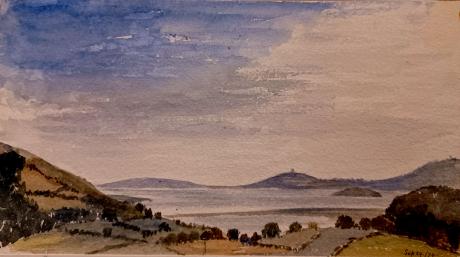"Towards Morecombe Bay nr Old Hall Milnthorpe Sept 29 1874"
Morecambe Bay is an estuary in north-west England, just to the south of the Lake District National Park. It is the largest expanse of intertidal mudflats and sand in the United Kingdom, covering a total area of 120 sq mi (310 km2). In 1974, the second largest gas field in the UK was discovered 25 mi (40 km) west of Blackpool, with original reserves of over 7 trillion cubic feet (tcf) (200 billion cubic metres). At its peak, 15% of Britain's gas supply came from the bay but production is now in decline. Morecambe Bay is also an important wildlife site, with abundant birdlife and varied marine habitats.

A panorama of most of Morecambe Bay looking from east (bottom of photo) to west (top of photo). Barrow-in-Furness and Walney Island can be seen in the upper part of the photo and Lancaster and Morecambe are visible in the lower left-hand corner of the photo.
The rivers Leven, Kent, Keer, Lune and Wyre drain into the Bay, with their various estuaries making a number of peninsulas within the bay. Much of the land around the bay is reclaimed, forming salt marshes used in agriculture. The bay is known for its wildlife populations, being a Special Area of Conservation, Special Protection Area and a Site of Special Scientific Interest,and there is a bird observatory at Walney Island. Some of the surrounding land is also a protected area, forming the Morecambe Bay Pavements, home to rare butterflies such as the high brown fritillary. The bay has rich cockle beds, which have been fished by locals for generations.
There are seven main islands in the bay, all to the west; Walney, Barrow, Sheep, Piel, Chapel, Foulney and Roa. Walney is substantially larger than the others, with its southern tip marking the north-western corner of the Bay. Sheep, Piel, Chapel and Foulney Islands are tidal and can be walked to at low tide with appropriate care. Local guidance should be sought if walking to Chapel or Piel islands as fast tides and quicksand can be extremely dangerous. Roa Island is linked to the mainland by a causeway, while Barrow Island has been connected to the mainland as part of the docks system at Barrow-in-Furness.

The extensive sandflats are the remains of a vast sandur or outwash plain established by meltwaters as the last ice age waned. Sea-level was still some 3m below present day levels at the start of the Holocene some 11,000 years ago.
The Greek geographer and astronomer Claudius Ptolemy (died c170 AD) referred in his writings to Morikambe eischusis as a location on Britain's west coast, lying between the Ribble and the Solway. The sixteenth-century scholar William Camden identified the locality as being near Silloth, hence the similar name of that bay but the eighteenth-century antiquarian John Horsley who translated Ptolemy into English in 1732 favoured it being the bay on the then Lancashire—Cumberland border. In 1771 historian John Whitaker took up this latter suggestion and the name appeared on maps subsequently. The first recorded to do so being one associated with Father Thomas West's Antiquities of Furness of 1774. Camden believed the name originated with two words meaning crooked sea whilst West offered up white/beautiful haven though current thought is that it refers to a curve of the sea.

The bay has quicksand and fast moving tides. There have been royally appointed local guides (holding the post of King's Guide to the Sands) for crossing the bay for centuries; appointment of guides is now delegated to a trust. This difficulty of crossing the bay added to the isolation of the land to its north which, due to the presence of the mountains of the Lake District, could only be reached by crossing these sands or by ferry, until the Furness Railway was built in 1857. This skirts the edge of the bay, crossing the various estuaries. The London-Glasgow railway also briefly runs alongside the bay – the only place where the West Coast Main Line actually runs alongside the coast.
The dangers presented by the bay were demonstrated in the 2004 Morecambe Bay cockling disaster when 23 undocumented immigrants from China were drowned by an incoming tide, after being cut off while harvesting cockles. Criminal prosecution of the gangmaster and his associates for manslaughter and aiding immigration offences resulted in terms of imprisonment.These events were covered in a drama film and a non-fiction documentary. The incident has had a lasting effect on the community and estuary harvesting regulations.
Morecambe Bay is also home to several of the UK's offshore wind farms: West of Duddon Sands, Burbo Bank, Walney, Barrow, and Ormonde.
Mary Keightley (1854-1946) was the youngest daughter of Archibald Keightley (1795-1877), executor of Sir Thomas Lawrence’s estate. She was a good amateur artist. Archibald Keightley (1795-1877), who was a solicitor who was the executor for Sir Thomas Lawrence, who had died earlier in 1830. Mr Keightley was responsible for the sale of Sir Thomas's collections, some of which were not paid for! There is a very interesting story about Sir Thomas's collection of old master drawings which were part of the assets Mr Keightley hadto dispose of. Following his work as a solicitor, Mr Keightley a few years later became the Registrar for the Charterhouse School, where he remained for 39 years.
Mary Keightley was born in 1854, in Charterhouse, Middlesex, England, United Kingdom, her father, Archibald Keightley, was 58 and her mother, Sarah Elizabeth Yates, was 41. She lived in London, England for about 20 years and Royal Borough of Kensington and Chelsea, London, England, United Kingdom in 1891. She died on 20 April 1946, in Camberley, Surrey, England, United Kingdom, at the age of 93.

